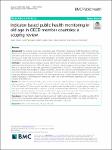Indicator-based public health monitoring in old age in OECD member countries: a scoping review
Grube, Maike Miriam
Möhler, Ralph
Fuchs, Judith
Gaertner, Beate
Scheidt-Nave, Christa
Background
The scoping review was conducted as part of the project “Improving Health Monitoring in Old Age” (IMOA) which aims at developing a conceptual framework with key indicators for a public health monitoring of the population aged 65 years and older in Germany. We systematically identified indicator-based monitoring systems that focus on health and wellbeing of older populations in member countries of the Organisation for Economic Co-operation and Development (OECD) and analysed them with regard to structure, development and content.
Methods
A systematic search strategy included searching the websites of national public health institutes, an additional internet search and a MEDLINE search via PubMed. Indicator systems were included if they presented data on a national level, if they were published or updated after 01/01/2007, if they relied on more than one data source and if they were available in English or German. Data on the structure and development of the indicator sets were extracted using a standardized documentation form, and a content analysis of the indicators was conducted using a pre-defined conceptual framework with three health areas and 11 health domains that is based on the Worlds Health Organization’s “World Report on Ageing and Health” and on the International Classification of Functioning, Disability and Health (ICF).
Results
Ten indicator-based monitoring systems met our inclusion criteria. Of these, six systems focused exclusively on older populations, and four offer a specific subset of indicators for older age. The number of indicators varied between 22 and 53 (median 32.5). Four systems were directly related to national public health or healthy ageing strategies, and two systems had been developed in consensus processes involving multiple stakeholders. The highest numbers of indicators could be assigned to the domains “health care”, “nursing and community care”, “wealth and poverty” and “physical health”. Overall, 47 different concepts could be identified in the monitoring systems.
Conclusion
Among indicator-based monitoring systems of health in older age identified in member countries of the OECD, there is considerable variation with regard to structure, development and content. The results will inspire the development of a public health monitoring of the older population in Germany.
Dateien zu dieser Publikation

